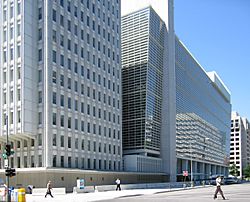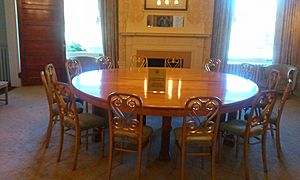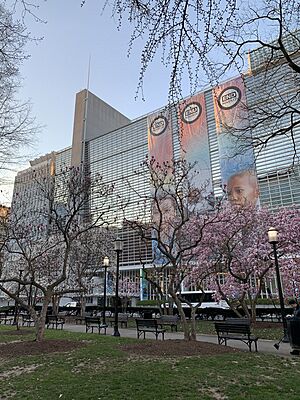World Bank facts for kids
 
The World Bank building in Washington, D.C.
|
|
| Established | July 7, 1944 |
|---|---|
| Type | International financial institution |
| Legal status | Treaty |
| Headquarters | 1818 H Street, NW Washington, D.C., U.S. |
|
Membership
|
189 countries (IBRD) 174 countries (IDA) |
|
Key people
|
|
|
Parent organization
|
World Bank Group |
The World Bank is a special organization that helps countries around the world. It gives out loans and grants (which are like gifts of money) to governments in countries that are still developing or have lower incomes. The main goal is to help these countries build important things and improve life for their people.
The World Bank is actually two main parts: the International Bank for Reconstruction and Development (IBRD) and the International Development Association (IDA). These two are part of a bigger family of five organizations called the World Bank Group. The World Bank started in 1944 after a big meeting called the Bretton Woods Conference. Its first loan went to France in 1947.
Today, the World Bank works to reduce poverty and help countries grow. It focuses on things like fighting climate change and supporting the United Nations' goals for a better world. It also works with other groups to share knowledge and train people.
Contents
- What is the World Bank Group?
- A Look at World Bank History
- World Bank and COVID-19
- How the World Bank Helps Countries
- Who Leads the World Bank?
- Member Countries
- Helping Countries Reduce Poverty
- Working on Global Issues
- Training and Knowledge Sharing
- Open Data and Research
- Criticisms and Challenges
- Images for kids
- See also
What is the World Bank Group?
The World Bank Group is a larger family of five international organizations. The "World Bank" usually refers to the first two organizations on this list:
- International Bank for Reconstruction and Development (IBRD)
- International Development Association (IDA)
- International Finance Corporation (IFC)
- Multilateral Investment Guarantee Agency (MIGA)
- International Centre for Settlement of Investment Disputes (ICSID)
A Look at World Bank History

The World Bank was created in 1944 at the Bretton Woods Conference. This meeting also created the International Monetary Fund (IMF). Both organizations are in Washington, D.C., and work closely together.
The idea was to give temporary loans to countries that needed help but couldn't get loans from regular banks. The World Bank could also ask countries to make certain changes to their policies to get a loan.
Early Years (1944–1974)

In its first years, the World Bank grew slowly. Many European countries were getting help from other places, like the Marshall Plan. So, the World Bank started focusing on countries outside Europe.
Until 1968, its loans were mainly for big building projects. These included things like seaports, highways, and power plants. The goal was for these projects to make enough money so the country could pay back the loan. In 1960, the International Development Association (IDA) was created. It gave "soft loans" (loans with very low interest or long repayment times) to developing countries.
The first country to get a loan was France in 1947. The loan was for $250 million. The World Bank watched closely to make sure the money was used correctly.
Helping Developing Countries (1974–1980)
From 1974 to 1980, the World Bank focused on helping people in developing countries meet their basic needs. The number and size of loans grew a lot. Loans went beyond just buildings to include social services like health and education.
This change happened under Robert McNamara, who became president in 1968. He helped the bank get more money from different sources around the world. However, this period also saw a big increase in debt for developing countries.
Focus on Debt and Reforms (1980–1989)
In the 1980s, the bank focused on helping countries deal with their large debts. It also pushed for "structural adjustment policies." These policies aimed to make countries' economies more efficient.
However, some groups, like UNICEF, said that these programs sometimes hurt children. They reported that health, nutrition, and education levels went down for millions of children in some parts of the world.
New Focus (1989–Present)
Starting in 1989, the World Bank began to change. It started working with environmental groups and other non-profit organizations. This was to make sure its projects didn't harm the environment. For example, in 1991, the bank said it would not fund projects that led to deforestation, especially in the Amazon rainforest.
The bank also started working on global health issues. It helps control diseases like malaria and provides vaccines. In 2000, it declared a "war on AIDS."
Traditionally, the president of the World Bank has always been from the United States. This is because the U.S. is the largest financial supporter of the bank. In 2012, for the first time, people from other countries were nominated.
In 2023, Ajay Banga became the new president. He is the first Indian American to lead the bank. He supports actions against climate change and aims to help low-income countries with their debts.
World Bank and COVID-19
During the COVID-19 pandemic, the World Bank helped countries get vaccines. In September 2020, it announced a $12 billion plan to provide vaccines to low and middle-income countries. By June 2022, it had given $10.1 billion to 78 countries for vaccines.
How the World Bank Helps Countries

The World Bank works to help countries reach important goals, like those set by the Millennium Development Goals. These goals aim to make the world a better place by fighting poverty and improving lives.
Here are some of the areas the World Bank focuses on:
- Ending Extreme Poverty and Hunger: The bank works to reduce the number of people living in extreme poverty and ensure more people have enough food.
- Achieving Universal Primary Education: It helps more children, especially girls, go to school.
- Promoting Gender Equality: The bank supports women's economic power and helps them have equal opportunities.
- Reducing Child Mortality: It works to improve survival rates for children under five, especially in places where many children die from preventable causes.
- Improving Maternal Health: The bank helps provide better healthcare for women during pregnancy and childbirth.
- Fighting Diseases: It helps control diseases like HIV/AIDS and malaria by providing treatment and joining global efforts.
- Ensuring Environmental Sustainability: The bank works to protect the environment while promoting development. This includes fighting deforestation and reducing greenhouse gas emissions.
- Building Global Partnerships: It works with other countries and organizations to achieve these goals together.
To make sure its projects are good for the environment and people, the World Bank has special rules called "Environmental and Social Safeguards." These rules help protect things like natural habitats, forests, and the rights of local communities.
Who Leads the World Bank?
The president of the World Bank leads the entire World Bank Group. This person is in charge of meetings and managing the bank. Traditionally, the president has been a U.S. citizen because the United States is the largest shareholder. The president serves a five-year term and can be re-elected.
The bank also has many vice presidents who manage different regions and areas of work. There are also 25 executive directors who, along with the president, make up the boards of directors.
World Bank Presidents
| Name | Dates | Nationality | Previous work |
|---|---|---|---|
| Eugene Meyer | 1946–1946 | Newspaper publisher and Chairman of the Federal Reserve | |
| John J. McCloy | 1947–1949 | Lawyer and US Assistant Secretary of War | |
| Eugene R. Black, Sr. | 1949–1963 | Bank executive with Chase and executive director with the World Bank | |
| George Woods | 1963–1968 | Bank executive with First Boston Corporation | |
| Robert McNamara | 1968–1981 | President of the Ford Motor Company, US Defense Secretary | |
| Alden W. Clausen | 1981–1986 | Lawyer, bank executive with Bank of America | |
| Barber Conable | 1986–1991 | New York State Senator and US Congressman | |
| Lewis T. Preston | 1991–1995 | Bank executive with J.P. Morgan | |
| James Wolfensohn | 1995–2005 | Corporate lawyer and banker | |
| Paul Wolfowitz | 2005–2007 | US Ambassador to Indonesia, US Deputy Secretary of Defense | |
| Robert Zoellick | 2007–2012 | Deputy Secretary of State and US Trade Representative | |
| Jim Yong Kim | 2012–2019 | Former Chair of Global Health at Harvard, president of Dartmouth College | |
| Kristalina Georgieva (acting) | 2019 | Former European Commissioner | |
| David Malpass | 2019–2023 | Under Secretary of the Treasury for International Affairs | |
| Ajay Banga | 2023–present | Former head of Mastercard |
Chief Economists
The Chief Economist is a very important role, helping guide the bank's economic research and policies.
| Name | Dates | Nationality |
|---|---|---|
| Hollis B. Chenery | 1972–1982 | |
| Anne Osborn Krueger | 1982–1986 | |
| Stanley Fischer | 1988–1990 | |
| Lawrence Summers | 1991–1993 | |
| Michael Bruno | 1993–1996 | |
| Joseph E. Stiglitz | 1997–2000 | |
| Nicholas Stern | 2000–2003 | |
| François Bourguignon | 2003–2007 | |
| Justin Yifu Lin | 2008–2012 | |
| Kaushik Basu | 2012–2016 | |
| Paul Romer | 2016–2018 | |
| Shanta Devarajan (Acting) | 2018–2018 | |
| Penny Goldberg | 2018–2020 | |
| Aart Kraay (Acting) | 2020–2020 | |
| Carmen Reinhart | 2020–2022 | |
| Indermit Gill | 2022–present |
Member Countries
The IBRD has 189 member countries, and the IDA has 174. To be a member of the World Bank, a country must also be a member of the International Monetary Fund (IMF).
Only a few countries in the world are not members of the World Bank. These include Andorra, Cuba, Liechtenstein, Monaco, and North Korea.
How Countries Vote
In 2010, the way countries vote at the World Bank was changed. This was done to give developing countries, especially China, more say. The countries with the most voting power are now the United States (15.85%), Japan (6.84%), China (4.42%), Germany (4.00%), and the United Kingdom (3.75%).
The goal of these changes was to make voting fairer and more open. Now, voting power is based on a country's economic size and how much it contributes to the IDA.
Helping Countries Reduce Poverty
For the poorest countries, the World Bank creates special "poverty reduction strategies." These plans are made with the local government and other groups. They look at the country's needs and its financial situation. Then, the World Bank helps with aid based on the country's goals for reducing poverty.
Many countries have promised money to the World Bank's IDA. This money helps about 80 poorer countries. The World Bank also gives out "Development Marketplace Awards." These awards fund projects that help people with low incomes.
Working on Global Issues
The World Bank works on many global issues and partners with other organizations.
Climate Change Efforts
The World Bank is very concerned about climate change. In 2012, its president, Jim Yong Kim, said that a world that is 4 degrees warmer must be avoided. He stressed that not acting on climate change threatens the world our children will live in.
The World Bank has increased its help for countries to deal with climate change. In 2017, it announced it would stop funding projects that use fossil fuels. However, some reports in 2019 suggested it still funded some oil and gas projects.
In 2021, the World Bank offered to help Kazakhstan move towards a low-carbon economy. The current president, Ajay Banga, strongly supports climate action.
Food Security Programs
The World Bank also works to improve food security around the world. This means making sure everyone has enough safe and nutritious food.
- Global Food Security Program: Started in 2010, this program helps countries improve agriculture and food production.
- Global Food Crisis Response Program: This program gives grants to countries to help them improve farm productivity.
- The bank is increasing its yearly spending on agriculture.
- It runs many nutrition programs, like providing vitamin A to children and school meals.
Training and Knowledge Sharing
The World Bank has programs to share knowledge and train people.
Global Development Learning Network (GDLN)
The Global Development Learning Network (GDLN) is a group of over 120 learning centers in nearly 80 countries. These centers work together to connect people across different countries. They share ideas and learn from each other about development issues.
GDLN helps non-profit groups, governments, and businesses work together. They use video conferences and other tools to share knowledge. Most of their activities are organized by small government agencies and non-profit groups.
Open Data and Research
The World Bank collects a lot of information and research about economies. It makes this information available to the public for free. This helps people reuse the data and learn from it. The bank's research papers are also available for anyone to read.
Criticisms and Challenges
The World Bank has faced some criticism over the years.
One common criticism is about how it is governed. Even though 188 countries are members, a few powerful countries have the most say. These countries provide most of the money and choose the bank's leaders. Some people argue that this means the bank's decisions are mostly based on the interests of these powerful countries.
In the 1990s, the World Bank and the IMF promoted policies called the "Washington Consensus." These policies encouraged things like reducing government control and selling state-owned businesses to private companies. Critics said these policies sometimes ignored fairness, jobs, and how well the changes were actually carried out. Some argued that these policies focused too much on economic growth numbers and not enough on improving people's lives.
Another criticism is that the World Bank sometimes focused too much on giving out loans. Critics wanted the bank to focus more on achieving real results in development within a set time. There have also been calls for the bank to do more to fight corruption.
Some people have protested against the World Bank and other similar organizations. These protests have happened around the world, like the "Battle of Seattle" in 1999.
A long-standing criticism is that the World Bank president has always been an American. This is because the U.S. provides the most funding. Critics say the bank should choose the best person for the job, no matter their nationality.
In 2021, an investigation found that some World Bank leaders had pressured staff to change data. This was done to make certain countries, like China and Saudi Arabia, look better in the bank's "Doing Business" reports.
In 2023, the World Bank paused new loans to Uganda. This was because Uganda passed a new law against homosexuality, which the World Bank said went against its values on human rights.
The World Bank also funded a program in Tanzania that was meant to help nature. However, this program was criticized because it led to serious human rights problems for the Maasai people.
Images for kids
-
The World Bank Group headquarters building in Washington, D.C.
See also
 In Spanish: Banco Mundial para niños
In Spanish: Banco Mundial para niños
- Clean Energy for Development Investment Framework
- The Economist Democracy Index
- Energy Sector Management Assistance Program (ESMAP)
- International Finance Corporation
- New Development Bank
- The Swiss constituency


